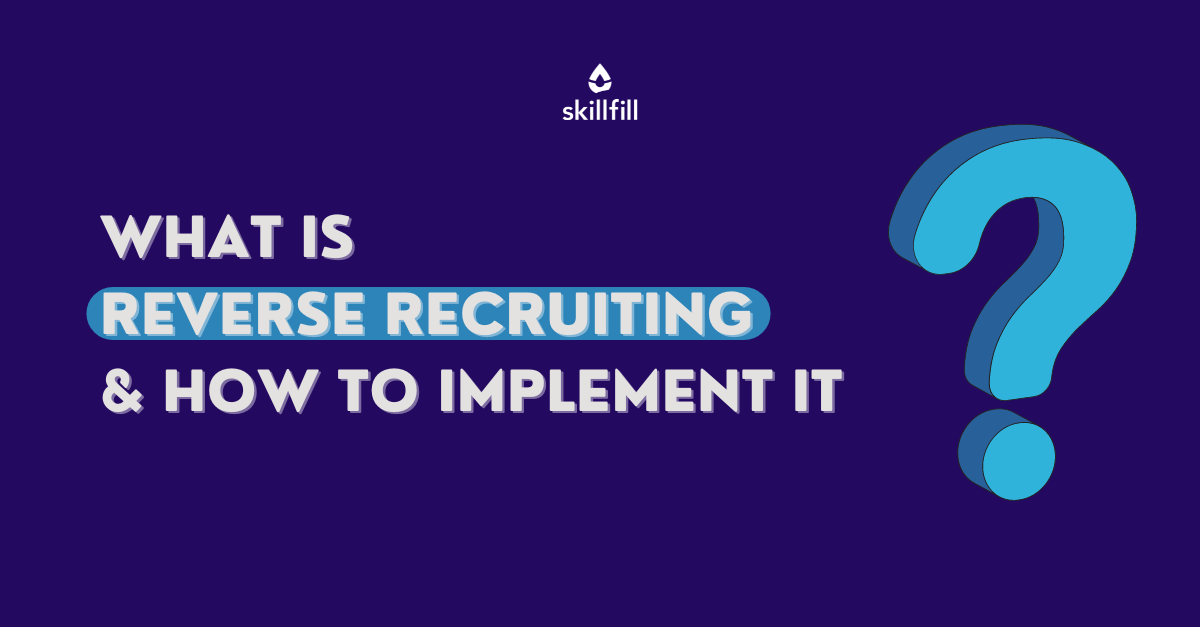Reverse Recruiting: A Fresh Strategy to Talent Procurement
Reverse Recruiting: A Fresh Strategy to Talent Procurement
Blog Article
Boost Your Hiring Video Game With Strategic Reverse Hiring Approaches
As the landscape of hiring evolves, organizations are increasingly turning to cutting-edge techniques such as critical reverse recruiting to obtain a competitive side in protecting leading ability. This change in frame of mind needs a thoughtful reconsideration of exactly how companies approach the employing procedure, focusing on bring in passive candidates instead than solely counting on energetic work seekers - reverse recruiting.
Understanding Calculated Reverse Hiring
Purposefully leveraging the principle of reverse recruiting can substantially boost your organization's ability purchase approach. By flipping the traditional recruitment strategy on its head, reverse recruiting involves proactively looking for and bring in passive candidates who may not be actively trying to find brand-new chances. This positive approach allows business to take advantage of a swimming pool of top quality talent that may not be easily accessible through conventional work posts alone.
Understanding the intricacies of calculated reverse recruiting is essential for its successful application. It requires a deep understanding of the industry landscape, competitor analysis, and the details skill collections that are in high need. reverse recruiting. By performing extensive research and leveraging market understandings, organizations can recognize and involve with top talent in an extra customized and targeted manner

Advantages of Reverse Recruiting
Reverse recruiting offers an unique technique to talent procurement by proactively engaging with passive candidates that may not be proactively looking for work opportunities. This approach enables companies to tap right into a pool of skill that standard recruiting approaches could overlook. One of the vital benefits of reverse recruiting is the ability to target prospects who are already used and pleased in their existing roles. These people are commonly leading performers in their respective areas, bringing useful skills and experience to the table.

Key Parts of Reverse Hiring
Having actually explored the advantages of reverse recruiting in targeting top performers that are material in their existing functions, it is crucial to comprehend the key elements that make this approach successful in drawing in easy candidates. Passive candidates are commonly not actively seeking new chances, so having a positive credibility as an employer can more ignite their passion.
Another important element is personalized outreach. Because easy prospects are not proactively searching for jobs, common employment messages are likely to be forgotten. Tailoring outreach efforts to highlight how the details abilities and experiences of the prospect line up with the company's needs can significantly enhance the chances of getting their interest.
Moreover, promoting partnerships with passive candidates over time is vital. Routinely involving with them via networking occasions, market seminars, and even periodic check-ins can help construct rapport and trust fund, making click here for info them more responsive to prospective work opportunities in the future. By including these vital elements right into reverse recruiting methods, organizations can effectively attract and employ leading talent from the pool of easy prospects.
Implementing Reverse Recruiting Strategies

Furthermore, developing engaging company branding and showcasing a favorable firm society can aid draw in easy candidates and motivate them to consider brand-new occupation chances. Building a talent neighborhood or skill pipe can likewise be helpful in nurturing relationships with easy prospects gradually, maintaining them involved and thinking about possible future duties within the company. Generally, executing reverse recruiting techniques needs an aggressive and site customized approach to ability purchase, concentrating on establishing purposeful links with easy candidates to drive long-lasting recruitment success.
Measuring Success in Reverse Recruiting
Reliable dimension of success in hiring methods requires a thorough assessment of vital efficiency signs and metrics to analyze the influence and effectiveness of ability purchase efforts. In the context of reverse recruiting, certain metrics can provide valuable insights into the efficiency and efficiency of the method. One crucial metric is the quality of prospects engaged with reverse recruiting networks. By measuring the conversion price of easy prospects right into energetic applicants or employs, companies can determine the efficiency of their reverse recruiting campaigns.
Additionally, tracking the time-to-fill statistics for settings filled via reverse recruiting can use important data on the efficiency of the procedure. A shorter time-to-fill suggests that the strategy is drawing in certified candidates without delay. Moreover, keeping track of retention rates amongst prospects recruited with reverse approaches can provide understandings right into the long-term success of the technique. High retention prices suggest that the candidates sourced with reverse recruiting are an excellent fit for the company, adding favorably to its total ability pool. By evaluating these essential metrics, services can successfully gauge the success of their reverse recruiting initiatives and make educated choices to enhance their skill purchase approaches.
Verdict
Finally, tactical reverse recruiting offers an one-of-a-kind approach to employing that concentrates on attracting leading talent with positive engagement and relationship-building. By leveraging this approach, organizations can gain an affordable side in the talent market and improve their recruitment outcomes. It is important to recognize the advantages, vital parts, and approaches of reverse recruiting to effectively implement and measure success in this cutting-edge approach to working with.
Report this page